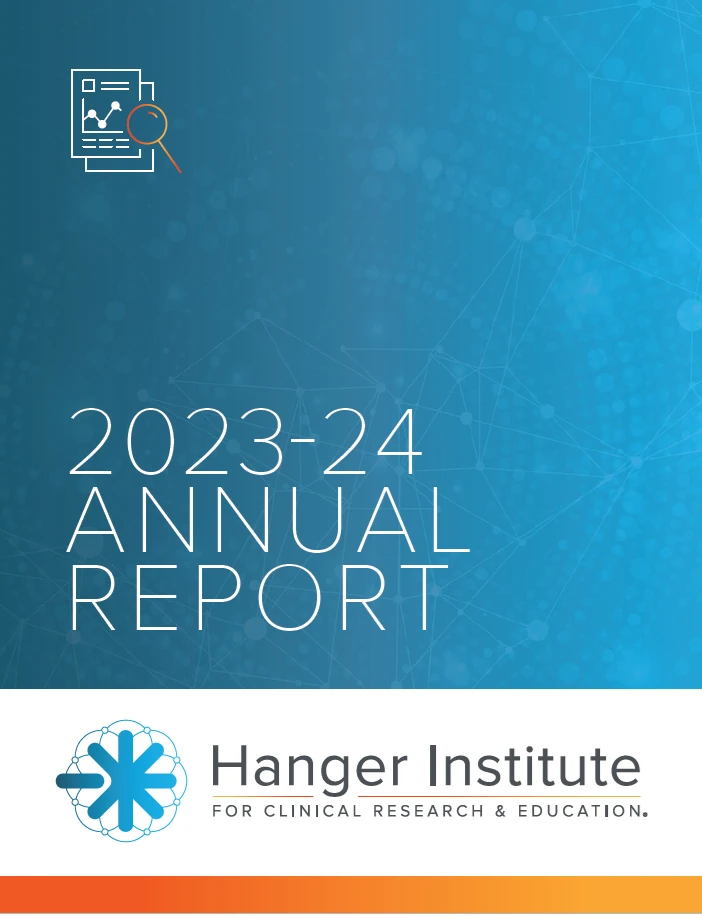The Hanger Institute for Clinical Research and Education released its 2023-24 Annual Report last week, and you don’t have to be a Hanger prosthetist—or even a Hanger patient—to make good use of it. About half of the 36-page document summarizes current evidence on some key frontiers in amputee care, including vascular-related limb loss, the aging curve for amputees, upper-limb device adoption, osseointegration, and demographic fault lines related to gender, geography, race, and so forth.
In other words, there’s something in here that applies to almost every amputee. And the findings are highly relevant, because they influence clinical practice throughout the O&P profession. If you’re looking for a user-friendly snapshot of the data informing your prosthetist’s thinking, look no further. The Annual Report equips you to participate in meaningful dialogue with your clinician and advocate more effectively for the outcomes that matter to you. And you don’t have to plow through 40 peer-reviewed journal articles to get there.
Here’s our Reader’s Digest version of the Annual Report, which is in turn a Reader’s Digest summary of the latest science underlying best practices in limb care. You can download the full document from the Institute’s website.
Vascular Disease and Limb Loss
Takeaway number one: If you lost a limb to diabetes or another vascular disease and were not referred to a prosthetist, demand to know why. A study cited in the Annual Report (page 10) found that nearly half of patients with vascular-related amputations were deemed too unhealthy for a prosthesis. But the Institute’s own MAAT studies (Mobility Analysis of AmpuTees) have found that, contrary to widely held beliefs, diabetes does not correlate with decreased prosthetic success, and peripheral vascular disease (PVD) has only a mild correlation with decreased mobility.
The logical inference is that many vascular amputees are incorrectly judged to be poor candidates for prosthetic success. That’s not to say that every vascular amputee is a good candidate for a prosthesis. But everyone is at least entitled to know the statistical profiles that guide referral decisions. If your care team doesn’t think you should even see a prosthetist for an initial consultation, ask them to cite the data—and if you think those data don’t fit your specific case, explain why. As the Annual Report notes, “The continued tracking and monitoring of this patient population allows for individualized interventions or changes in the patient’s care plan.”
Takeaway number two: If you do get fitted for a prosthesis after a diabetes- or PVD-related amputation, certain types of prosthetic feet might be your best options. “Patients with diabetic/dysvascular amputation fit with a microprocessor foot (MPF) or vertical shock-loading pylon type foot (L5987) had significantly higher mobility compared to other foot types,” the report states, citing another study in the MAAT series. Vascular amputees with flex-walk and flex-foot components had the worst mobility scores.
Finally, the report summarizes a finding that’s driving a big change in Medicare coverage: Vascular above-knee amputees are nearly three times more likely to suffer a serious (and financially expensive) fall injury if they aren’t fitted with a microprocessor knee. A related finding: Vascular disease increases fall risk by roughly 75 percent. If you’re a vascular AK amputee being fitted with a non-MPK device, ask your clinician—and your insurer—to explain how that decision makes sense, either medically or financially.
Demography and Mobility
Two weeks ago we cited new research showing that women are less likely than men to get referred to a prosthetist and wait longer to receive a prosthesis if they do get referred. Reinforcing those findings, the Annual Report cites a finding from the Gender, Geography, and Employment study (2023) that women are significantly less mobile than men after limb loss. “This suggests that our female patients may benefit from additional encouragement and attention in their prosthetic rehabilitation,” the report notes. If you’re one of those female patients, insist on getting the attention you need.
Another finding: Individuals living in the South are more likely than average to report poor mobility, whereas individuals in the Northeast are more likely to report above-average mobility. Those conclusions align with multiple other studies, which cite the South’s lower overall access to healthcare as one major factor in the regional disparity. Such inequities won’t be easy to overcome via individual patient advocacy, but if you’re in the South and you think you deserve better care, don’t give up.
Amputees and Aging
“To provide best-in-class care, we need to understand where our patients are today and where we see them progressing in the future,” the Annual Report states. Toward that end, the document includes a simple tool for setting realistic expectations throughout the aging trajectory, using data from the Institute’s 2023 CASTLE 1 study (Creating Adjusted Scores Targeting mobiLity Empowerment). Although the graph shows a relatively steep dropoff in mobility after age 80, the decline between ages 40something and 70something is much gentler—and the curve can be flattened even further via more targeted rehabilitation, better use of technology (including more widespread use of microprocessor knees and feet), and overall health and exercise guidance.
A second consideration in this category: Fall risk increases significantly with age, not just among amputees but across the general population. However, lower-limb amputees are roughly 50 percent more likely to suffer an injurious fall than non-amputees, making fall prevention a critical focus. “Armed with this information,” the report states, “we can focus rehabilitation efforts on improving and/or maintaining mobility as the patient continues to age.”
Upper-Limb Prosthesis Function
The Annual Report contains a suite of findings related to successful adoption of upper-limb prosthetic devices. One key conclusion: Upper-limb amputees regard bimanual function as a critical component of their own well-being. “Bimanual function” (ie, tasks involving two hands) is heavily implicated in daily activities such as eating and dressing. Yet until very recently, there hasn’t been a verified methodology for measuring the effect of prosthetic devices on such tasks. The Annual Report summarizes such a methodology on page 15. If you’re an upper-limb amputee who’s dissatisfied with the level of function your prosthesis affords, this set of benchmarks might provide some useful guidance to you and your clinician.
Another benchmark cited in the report: Upper-limb amputees engage in bilateral tasks (involving both the prosthetic limb and the organic limb) for roughly four hours a day, on average. If you’re falling short of that standard, work with your whole care team—including your prosthetist, PT/OT, rehab doctor, possibly your surgeon—to figure out whether you’d benefit from a different device, better training on how to use your current device, or some other type of intervention.
You can download a full copy of the Hanger Institute for Clinical Research and Education 2023-24 Annual Report at this link.





